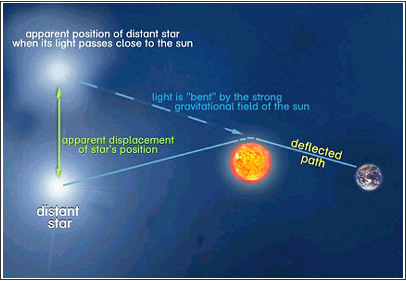The General Relativity and light
General relativity predicts that the curvature of space-time results in the apparent bending of light rays passing through gravitational fields and in an apparent reduction of their speeds of propagation. The bending was first observed, within a couple of years of Einstein's publication of the new theory, during a total eclipse, when stellar images near the occulted disk of the Sun appeared displaced by fractions of 1/ of arc from their usual locations in the sky.
 Einstein tried to convince his colleagues that light could be bent by a gravitational field at least two years before the previously mentioned ellipse. The truth is that nobody believed him. Actually, many scientists used to scoff him. The first he did after the eclipse was to call to his mother to announce her that now all the others could not deny his thoughts anymore.
Einstein tried to convince his colleagues that light could be bent by a gravitational field at least two years before the previously mentioned ellipse. The truth is that nobody believed him. Actually, many scientists used to scoff him. The first he did after the eclipse was to call to his mother to announce her that now all the others could not deny his thoughts anymore.
The associated delay in travel time was observed in the late 1960s, when ultra intense radar pulses were reflected off Mercury and Venus just as these planets were passing behind the Sun. These experiments are difficult to perform and their accuracy is difficult to evaluate, but it seems conservative to conclude that they confirm the relativistic effect within a few parts in 100. Finally, extended massive objects such as galaxies may act as "gravitational lenses", providing more than one optical path for light emanating from a source far behind the lens and thus producing multiple images. Such multiple images, typically of quasars, had been discovered by the early 1980s.
Related links (external pages)